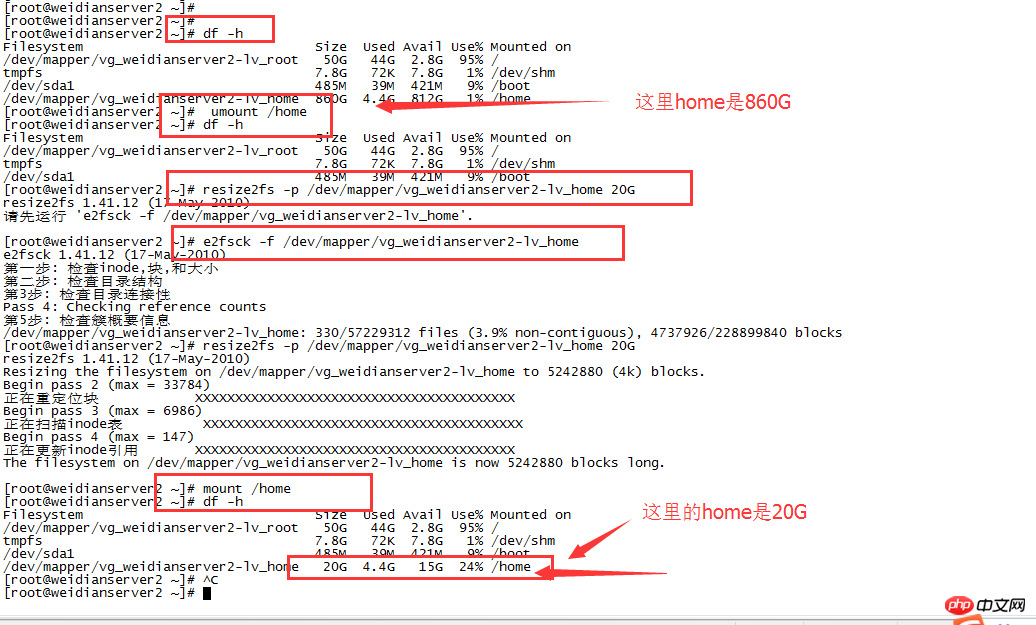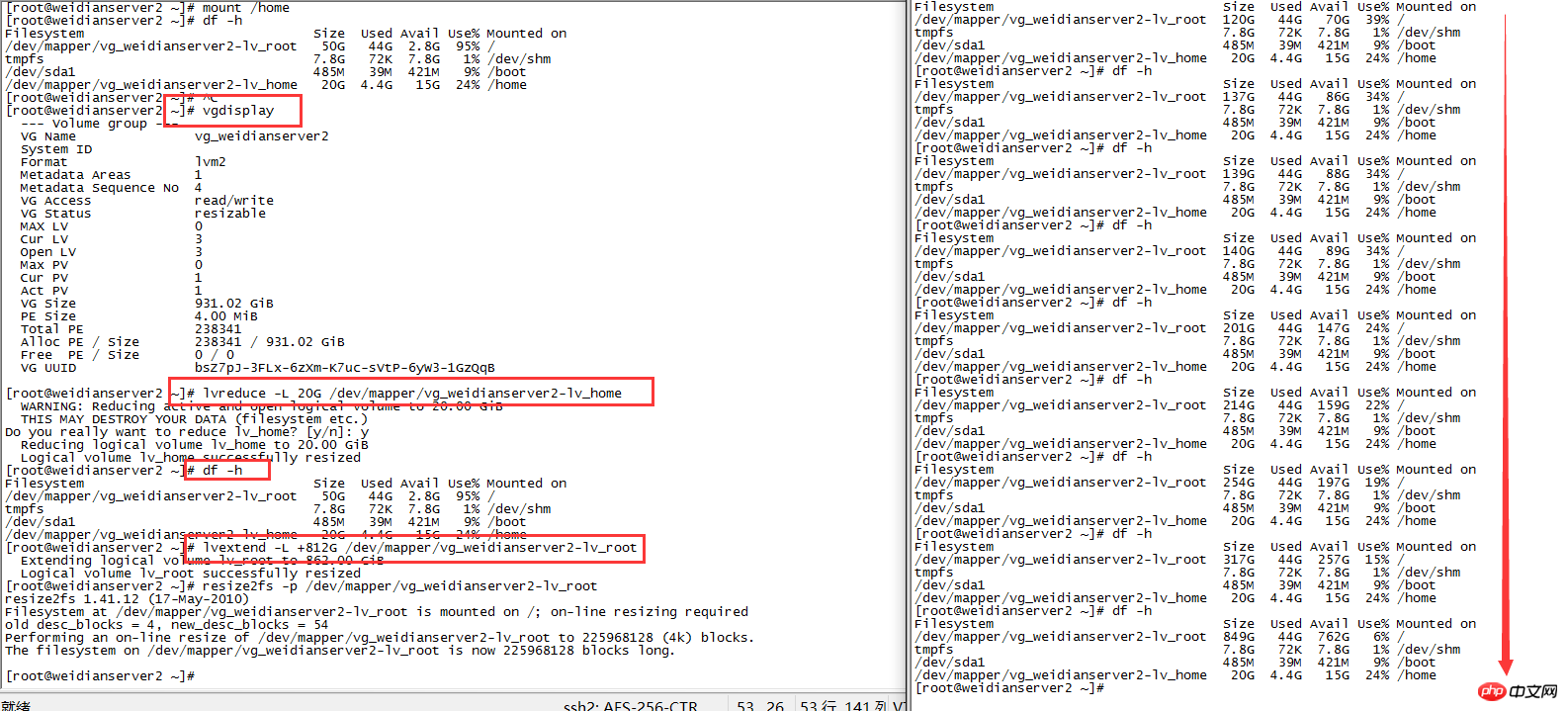 Operation and Maintenance
Operation and Maintenance
 Linux Operation and Maintenance
Linux Operation and Maintenance
 Adjust the size of home and root partitions under CentOS
Adjust the size of home and root partitions under CentOS
Adjust the size of home and root partitions under CentOS
Since we sometimes cannot predict or use the wrong drive letter partition, it often causes great inconvenience in our subsequent operations. Here I will record the wrong partition and then store the home and root partitions. The entire process of space resizing!
①Check the partition status of our existing machine
Centos download:
[root@weidianserver2 ~]# df -h Filesystem Size Used Avail Use% Mounted on /dev/mapper/vg_weidianserver2-lv_root 50G 44G 2.8G 95% / tmpfs 7.8G 72K 7.8G 1% /dev/shm /dev/sda1 485M 39M 421M 9% /boot /dev/mapper/vg_weidianserver2-lv_home 860G 4.4G 812G 1% /home
We can find the root partition and home Partitioning creates great irrationality, so here we will shrink the storage in the home partition and add the compressed storage to the root!
②First uninstall our home partition and compress the size of our home partition
[root@weidianserver2 ~]# umount /home [root@weidianserver2 ~]# df -h Filesystem Size Used Avail Use% Mounted on /dev/mapper/vg_weidianserver2-lv_root 50G 44G 2.8G 95% / tmpfs 7.8G 72K 7.8G 1% /dev/shm /dev/sda1 485M 39M 421M 9% /boot [root@weidianserver2 ~]# resize2fs -p /dev/mapper/vg_weidianserver2-lv_home 20G resize2fs 1.41.12 (17-May-2010) 请先运行 'e2fsck -f /dev/mapper/vg_weidianserver2-lv_home'. [root@weidianserver2 ~]# e2fsck -f /dev/mapper/vg_weidianserver2-lv_home e2fsck 1.41.12 (17-May-2010) 第一步: 检查inode,块,和大小 第二步: 检查目录结构 第3步: 检查目录连接性 Pass 4: Checking reference counts 第5步: 检查簇概要信息 /dev/mapper/vg_weidianserver2-lv_home: 330/57229312 files (3.9% non-contiguous), 4737926/228899840 blocks [root@weidianserver2 ~]# resize2fs -p /dev/mapper/vg_weidianserver2-lv_home 20G resize2fs 1.41.12 (17-May-2010) Resizing the filesystem on /dev/mapper/vg_weidianserver2-lv_home to 5242880 (4k) blocks. Begin pass 2 (max = 33784) 正在重定位块 XXXXXXXXXXXXXXXXXXXXXXXXXXXXXXXXXXXXXXXX Begin pass 3 (max = 6986) 正在扫描inode表 XXXXXXXXXXXXXXXXXXXXXXXXXXXXXXXXXXXXXXXX Begin pass 4 (max = 147) 正在更新inode引用 XXXXXXXXXXXXXXXXXXXXXXXXXXXXXXXXXXXXXXXX The filesystem on /dev/mapper/vg_weidianserver2-lv_home is now 5242880 blocks long.
③We can see from the running results that we have compressed our home to 20G, At this time we can reload our home directory
[root@weidianserver2 ~]# mount /home [root@weidianserver2 ~]# df -h Filesystem Size Used Avail Use% Mounted on /dev/mapper/vg_weidianserver2-lv_root 50G 44G 2.8G 95% / tmpfs 7.8G 72K 7.8G 1% /dev/shm /dev/sda1 485M 39M 421M 9% /boot /dev/mapper/vg_weidianserver2-lv_home 20G 4.4G 15G 24% /home
This completes the compression and reloading of home, as shown below:

④We have processed the home block in the above three steps, but our free hard disk has not been added to the root, so next we will add the compressed disk to the root:
[root@localhost ~]# lvextend -L +812G /dev/mapper/vg_weidianserver2-lv_root 注:lvextend -L +283G为在文件系统上增加283G [root@localhost ~]# resize2fs -p /dev/mapper/vg_weidianserver2-lv_root
It takes a little time to reload and mount, but we can also continuously check the size of the drive letter during this time. At this time, we will find that the size of the root drive letter will be a little bit smaller. increase, as shown below:

From the final result of the above picture, we can see that we compressed the free drive letter in home into 812G and added it to root, so that we The root space has been increased instantly; finally, thank you for reading. If you have any questions, you can leave a message for discussion. Thank you!
The above is the detailed content of Adjust the size of home and root partitions under CentOS. For more information, please follow other related articles on the PHP Chinese website!

Hot AI Tools

Undresser.AI Undress
AI-powered app for creating realistic nude photos

AI Clothes Remover
Online AI tool for removing clothes from photos.

Undress AI Tool
Undress images for free

Clothoff.io
AI clothes remover

AI Hentai Generator
Generate AI Hentai for free.

Hot Article

Hot Tools

Notepad++7.3.1
Easy-to-use and free code editor

SublimeText3 Chinese version
Chinese version, very easy to use

Zend Studio 13.0.1
Powerful PHP integrated development environment

Dreamweaver CS6
Visual web development tools

SublimeText3 Mac version
God-level code editing software (SublimeText3)

Hot Topics
 1378
1378
 52
52
 How to optimize CentOS HDFS configuration
Apr 14, 2025 pm 07:15 PM
How to optimize CentOS HDFS configuration
Apr 14, 2025 pm 07:15 PM
Improve HDFS performance on CentOS: A comprehensive optimization guide to optimize HDFS (Hadoop distributed file system) on CentOS requires comprehensive consideration of hardware, system configuration and network settings. This article provides a series of optimization strategies to help you improve HDFS performance. 1. Hardware upgrade and selection resource expansion: Increase the CPU, memory and storage capacity of the server as much as possible. High-performance hardware: adopts high-performance network cards and switches to improve network throughput. 2. System configuration fine-tuning kernel parameter adjustment: Modify /etc/sysctl.conf file to optimize kernel parameters such as TCP connection number, file handle number and memory management. For example, adjust TCP connection status and buffer size
 Difference between centos and ubuntu
Apr 14, 2025 pm 09:09 PM
Difference between centos and ubuntu
Apr 14, 2025 pm 09:09 PM
The key differences between CentOS and Ubuntu are: origin (CentOS originates from Red Hat, for enterprises; Ubuntu originates from Debian, for individuals), package management (CentOS uses yum, focusing on stability; Ubuntu uses apt, for high update frequency), support cycle (CentOS provides 10 years of support, Ubuntu provides 5 years of LTS support), community support (CentOS focuses on stability, Ubuntu provides a wide range of tutorials and documents), uses (CentOS is biased towards servers, Ubuntu is suitable for servers and desktops), other differences include installation simplicity (CentOS is thin)
 Centos shutdown command line
Apr 14, 2025 pm 09:12 PM
Centos shutdown command line
Apr 14, 2025 pm 09:12 PM
The CentOS shutdown command is shutdown, and the syntax is shutdown [Options] Time [Information]. Options include: -h Stop the system immediately; -P Turn off the power after shutdown; -r restart; -t Waiting time. Times can be specified as immediate (now), minutes ( minutes), or a specific time (hh:mm). Added information can be displayed in system messages.
 Centos configuration IP address
Apr 14, 2025 pm 09:06 PM
Centos configuration IP address
Apr 14, 2025 pm 09:06 PM
Steps to configure IP address in CentOS: View the current network configuration: ip addr Edit the network configuration file: sudo vi /etc/sysconfig/network-scripts/ifcfg-eth0 Change IP address: Edit IPADDR= Line changes the subnet mask and gateway (optional): Edit NETMASK= and GATEWAY= Lines Restart the network service: sudo systemctl restart network verification IP address: ip addr
 What files do you need to modify in HDFS configuration CentOS?
Apr 14, 2025 pm 07:27 PM
What files do you need to modify in HDFS configuration CentOS?
Apr 14, 2025 pm 07:27 PM
When configuring Hadoop Distributed File System (HDFS) on CentOS, the following key configuration files need to be modified: core-site.xml: fs.defaultFS: Specifies the default file system address of HDFS, such as hdfs://localhost:9000. hadoop.tmp.dir: Specifies the storage directory for Hadoop temporary files. hadoop.proxyuser.root.hosts and hadoop.proxyuser.ro
 CentOS HDFS performance tuning tips
Apr 14, 2025 pm 06:00 PM
CentOS HDFS performance tuning tips
Apr 14, 2025 pm 06:00 PM
CentOS Platform Hadoop Distributed File System (HDFS) Performance Optimization Guide Optimizing HDFS Performance is a multi-faceted issue, and multiple parameters need to be adjusted for specific situations. The following are some key optimization strategies: 1. Memory management adjusts the NameNode and DataNode memory configuration: reasonably configure the HADOOP_NAMENODE_OPTS and HADOOP_DATANODE_OPTS environment variables according to the actual memory size of the server to optimize memory utilization. Enable large page memory: For high memory consumption applications (such as HDFS), enabling large page memory can reduce memory page allocation and management overhead and improve efficiency. 2. Disk I/O optimization uses high-speed storage
 How is the GPU support for PyTorch on CentOS
Apr 14, 2025 pm 06:48 PM
How is the GPU support for PyTorch on CentOS
Apr 14, 2025 pm 06:48 PM
Enable PyTorch GPU acceleration on CentOS system requires the installation of CUDA, cuDNN and GPU versions of PyTorch. The following steps will guide you through the process: CUDA and cuDNN installation determine CUDA version compatibility: Use the nvidia-smi command to view the CUDA version supported by your NVIDIA graphics card. For example, your MX450 graphics card may support CUDA11.1 or higher. Download and install CUDAToolkit: Visit the official website of NVIDIACUDAToolkit and download and install the corresponding version according to the highest CUDA version supported by your graphics card. Install cuDNN library:
 Centos stops maintenance 2024
Apr 14, 2025 pm 08:39 PM
Centos stops maintenance 2024
Apr 14, 2025 pm 08:39 PM
CentOS will be shut down in 2024 because its upstream distribution, RHEL 8, has been shut down. This shutdown will affect the CentOS 8 system, preventing it from continuing to receive updates. Users should plan for migration, and recommended options include CentOS Stream, AlmaLinux, and Rocky Linux to keep the system safe and stable.



